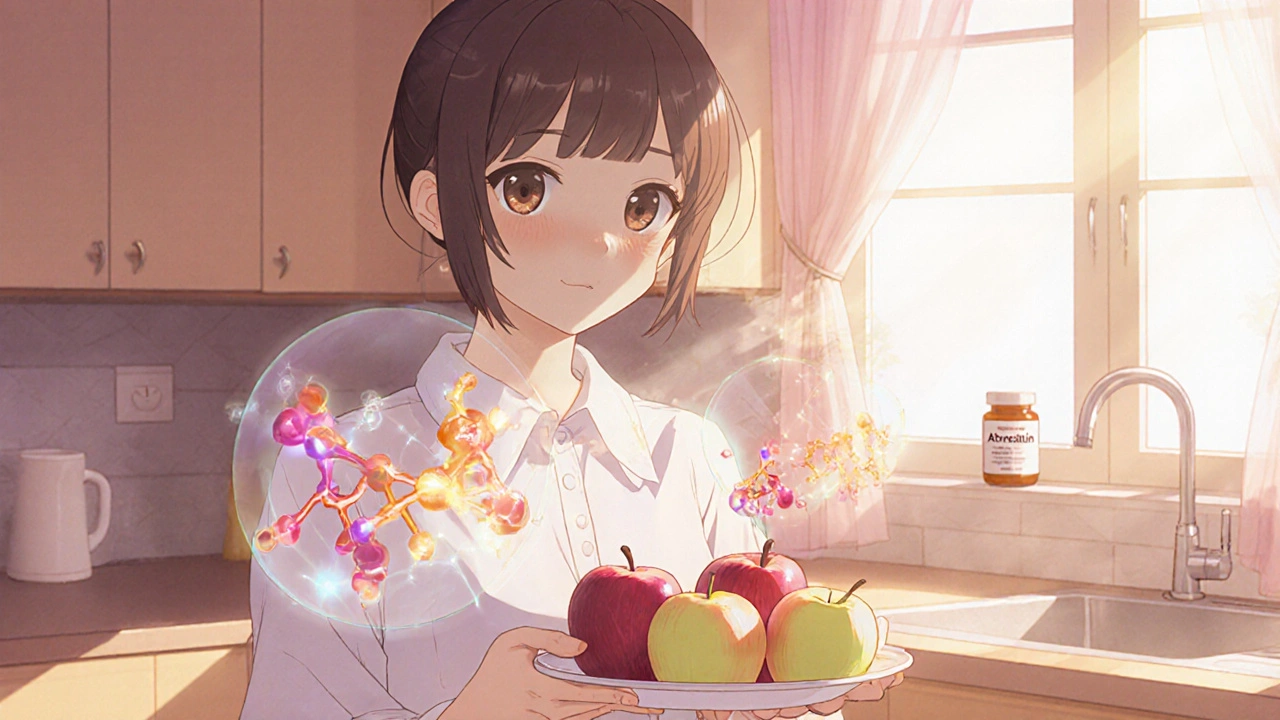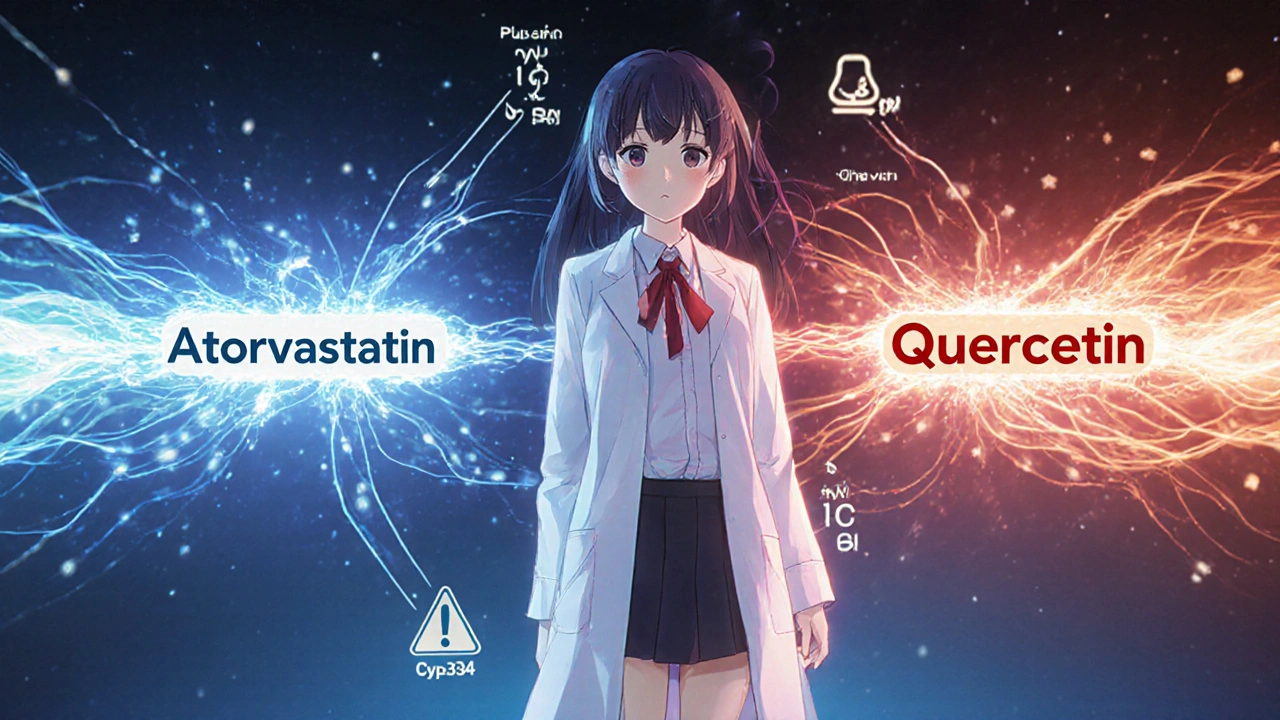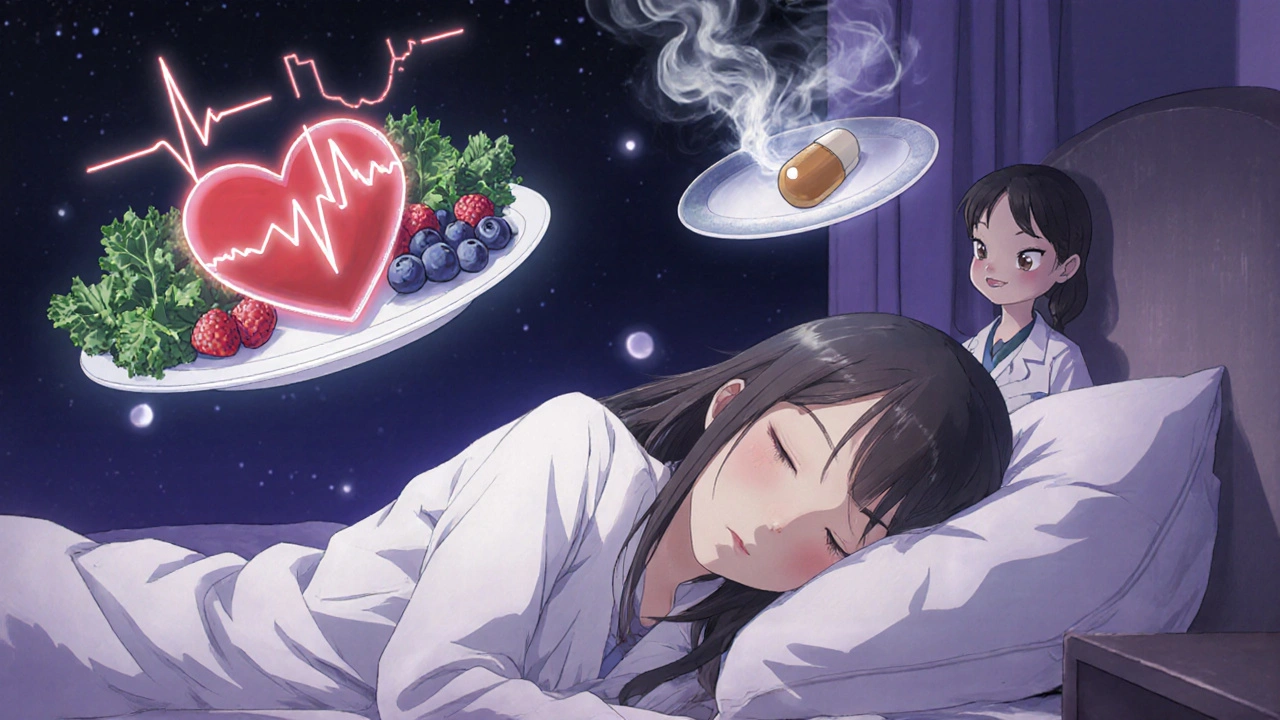Atorvastatin and Quercetin: What You Need to Know About Combining Them
 Nov, 18 2025
Nov, 18 2025
Many people take atorvastatin to lower their cholesterol and reduce heart disease risk. But if you’re also using quercetin - a natural compound found in apples, onions, and supplements - you might be wondering if it’s safe to take both together. The short answer? It’s not dangerous for most people, but it’s not harmless either. The real issue isn’t about poisoning or sudden side effects. It’s about how these two substances quietly change how your body handles medication, and what that means for your long-term health.
What is atorvastatin?
Atorvastatin is a statin drug used to lower LDL (bad) cholesterol and triglycerides while raising HDL (good) cholesterol. Also known as Lipitor, it was first approved in 1996 and is one of the most prescribed medications in the world. It works by blocking an enzyme called HMG-CoA reductase, which your liver uses to make cholesterol. Over time, this reduces plaque buildup in arteries and lowers the risk of heart attacks and strokes.
Most people take atorvastatin once a day, with doses ranging from 10 mg to 80 mg. It’s not a quick fix - it takes weeks to see full effects. Common side effects include muscle aches, digestive upset, and occasional liver enzyme changes. Rare but serious risks include rhabdomyolysis (muscle breakdown) and increased blood sugar levels, especially in people with prediabetes.
What is quercetin?
Quercetin is a flavonoid antioxidant found naturally in foods like capers, red onions, kale, berries, and green tea. It’s also sold as a dietary supplement, often marketed for immune support, allergy relief, and anti-inflammatory benefits. Unlike prescription drugs, quercetin isn’t regulated by the FDA for safety or effectiveness in treating disease.
People typically take quercetin in doses between 500 mg and 1,000 mg per day. Some studies suggest it may help reduce inflammation, lower blood pressure slightly, and even improve exercise performance. But most of this evidence comes from lab studies or small human trials. There’s no solid proof that quercetin prevents heart disease on its own.
How do they interact?
The main concern isn’t that quercetin cancels out atorvastatin. It’s that quercetin can interfere with how your body breaks down the drug.
Atorvastatin is processed in your liver by an enzyme system called CYP3A4. Quercetin is a known inhibitor of CYP3A4. That means when you take quercetin, it slows down the enzyme that normally clears atorvastatin from your body. The result? More atorvastatin stays in your bloodstream longer than intended.
This isn’t theoretical. A 2021 study published in the Journal of Clinical Pharmacology showed that quercetin increased the blood concentration of atorvastatin by up to 35% in healthy volunteers. That’s a significant jump - enough to raise the risk of side effects like muscle pain, weakness, or even rare cases of kidney damage from muscle breakdown.
It’s not just quercetin. Grapefruit juice does the same thing - and it’s why doctors warn patients not to drink it with statins. Quercetin is essentially the concentrated, supplement version of that effect.

Who should be extra careful?
Not everyone who takes quercetin and atorvastatin will have problems. But some people are at higher risk:
- Those taking higher doses of atorvastatin (60 mg or 80 mg)
- People over 65, because liver and kidney function decline with age
- Those with existing muscle disorders or kidney disease
- Anyone taking other medications that also affect CYP3A4 - like certain antibiotics, antifungals, or blood pressure drugs
- People who take quercetin supplements daily, especially in doses above 500 mg
If you’re healthy, young, and on a low dose of atorvastatin (10 mg or 20 mg), the risk is low - but still not zero. The problem is that side effects like muscle pain are easy to ignore. You might think it’s just from working out. But if you’re taking quercetin, it could be the combination.
What should you do?
You don’t need to stop quercetin cold turkey. But you need to be smart about it.
First, talk to your doctor or pharmacist. Tell them exactly what supplements you take - not just the big ones, but the small pills you forget to mention. Many people don’t realize their doctor needs to know about supplements too.
Second, consider timing. If you take quercetin at night and atorvastatin in the morning, you might reduce the overlap. But this isn’t a guaranteed fix. The enzymes stay busy for hours. The safest approach is to avoid high-dose quercetin supplements altogether while on atorvastatin.
Third, get your blood checked. Your doctor can order a simple blood test to check for elevated creatine kinase (CK), a marker of muscle damage. If your CK is rising and you’re taking quercetin, it’s a red flag.
And if you want the benefits of quercetin without the risk? Eat more of the foods that contain it. One medium red onion has about 40 mg of quercetin. A cup of kale has around 15 mg. You’d need to eat pounds of these foods daily to reach supplement levels. Food sources won’t overload your system the way pills do.

What about other supplements?
Quercetin isn’t the only supplement that plays nice with statins - or doesn’t. Here’s a quick look at a few others:
| Supplement | Interaction Risk | Why |
|---|---|---|
| Coenzyme Q10 | Low | Some people take it to ease statin-related muscle pain, but evidence is mixed. Safe to use. |
| Red yeast rice | High | Contains natural statins. Combining it with atorvastatin can lead to dangerous overdose. |
| Niacin (Vitamin B3) | Medium | Can raise HDL but increases flushing and liver stress. Use only under medical supervision. |
| Garlic supplements | Low to medium | May slightly lower cholesterol but can thin blood. Risk of bleeding if combined with other meds. |
| Green tea extract | Medium | Contains catechins that may inhibit CYP3A4 - similar to quercetin. |
Red yeast rice is especially risky. It contains monacolin K, which is chemically identical to lovastatin - another statin. Taking it with atorvastatin is like doubling your dose without your doctor knowing. That’s how serious muscle damage starts.
What’s the bottom line?
Atorvastatin saves lives. Quercetin supplements don’t. If you’re taking quercetin to feel healthier, you’re better off eating more vegetables, getting enough sleep, and walking daily. Those habits have proven, powerful effects on cholesterol and heart health - without the hidden risks.
If you’re already taking quercetin supplements, don’t panic. But do stop taking them until you’ve talked to your doctor. Bring your supplement bottle with you. Write down what you take and how much. Ask: "Could this be making my statin too strong?"
There’s no magic supplement that replaces medication. But there are plenty of simple, safe ways to support your heart - without accidentally hurting yourself.
Can I take quercetin with atorvastatin if I eat it in food?
Yes. Getting quercetin from foods like onions, apples, or broccoli is safe and unlikely to interfere with atorvastatin. The amount you get from diet is too low to affect liver enzymes significantly. Supplements, however, deliver concentrated doses - and that’s where the risk begins.
What are the signs that quercetin is affecting my atorvastatin?
Watch for unexplained muscle pain, weakness, or tenderness - especially in your thighs or shoulders. Dark urine, fatigue, or nausea can also signal muscle breakdown. If you notice these symptoms and you’re taking quercetin supplements, stop them immediately and contact your doctor.
Is there a safe dose of quercetin if I’m on atorvastatin?
There’s no officially safe dose of quercetin supplements when taking atorvastatin. Even 250 mg daily may increase drug levels. The safest choice is to avoid quercetin supplements entirely. If you’re determined to use them, your doctor can monitor your blood levels and muscle enzymes - but this isn’t routine care.
Does quercetin lower cholesterol on its own?
Some small studies suggest quercetin may slightly lower LDL cholesterol and blood pressure, but the effect is weak - around 5% at most. It’s nowhere near as effective as atorvastatin, which can lower LDL by 30-50%. Don’t rely on quercetin to replace your medication.
What should I take instead of quercetin supplements?
Focus on proven heart-healthy habits: eat more fiber (oats, beans, lentils), get 150 minutes of walking per week, maintain a healthy weight, and limit added sugar and saturated fats. If you need extra help, ask your doctor about plant sterols or omega-3 supplements - both have stronger evidence than quercetin.
Next steps
If you’re on atorvastatin and taking quercetin supplements, here’s what to do next:
- Stop taking quercetin supplements for 7 days.
- Write down all other supplements and medications you take.
- Schedule a quick appointment with your doctor or pharmacist.
- Ask for a blood test to check your creatine kinase (CK) and liver enzymes.
- Reconsider why you’re taking quercetin - and whether food sources are enough.
Heart health isn’t about finding the next miracle supplement. It’s about consistency, awareness, and avoiding hidden risks. Atorvastatin does the heavy lifting. You don’t need to add more to the plate - unless you know exactly what you’re adding.

Herbert Scheffknecht
November 19, 2025 AT 09:14Look, we’re all chasing the next miracle compound like it’s the Holy Grail, but here’s the truth: your liver doesn’t care if it’s from a pill or a salad. Quercetin in food? Fine. Quercetin in a capsule you bought because some influencer said it ‘detoxes your mitochondria’? That’s just biohacking delusion wrapped in a vegan label. Atorvastatin’s been saving lives for decades. Don’t turn your kitchen into a pharmacology lab.
Jessica Engelhardt
November 20, 2025 AT 06:59So you’re telling me the FDA lets Big Pharma sell statins but cracks down on natural quercetin? That’s not science, that’s corporate control. You think they want you healthy? They want you dependent. My cousin took quercetin and his cholesterol dropped 20 points. No script. No side effects. Just pure plant power. The system hates that.
Martin Rodrigue
November 20, 2025 AT 23:03While the pharmacokinetic interaction between quercetin and atorvastatin via CYP3A4 inhibition is well-documented in peer-reviewed literature, the clinical significance remains context-dependent. A 35% increase in AUC does not automatically equate to myopathy risk in all populations. Risk stratification must account for genetic polymorphisms in SLCO1B1, renal function, and concomitant medications. The recommendation to discontinue quercetin supplementation should be individualized, not universal.
Sherri Naslund
November 21, 2025 AT 19:37ok so like i read this and i was like wtf why are we even talking about this like if you eat an onion you're fine but if you take a pill you're gonna die?? that's insane. also i took quercetin for 3 months and my allergies vanished but my muscles hurt so i stopped and now i'm fine. also who even wrote this article?? feels like a pharma bot. also why is grapefruit juice the bad guy but onions are chill??
Ashley Miller
November 22, 2025 AT 14:23They’re all lying. The real reason they say quercetin is dangerous? Because it’s cheap. It grows in your backyard. It doesn’t need a patent. The statin industry makes billions. They need you scared of onions so you keep buying pills. And don’t get me started on the ‘blood test’ suggestion - CK levels are manipulated. They want you dependent. Wake up.
Lauren Hale
November 22, 2025 AT 20:14There’s so much noise out there about supplements, but this post cuts through it with clarity. If you’re on atorvastatin, your priority should be consistency and safety - not chasing the next ‘natural boost.’ Eating more veggies? Perfect. Taking a 1000mg quercetin capsule because you saw it on Instagram? That’s playing roulette with your muscles. Talk to your pharmacist. Bring your supplement bottle. No shame in asking. Your heart will thank you.
Greg Knight
November 24, 2025 AT 04:40Hey, I get it - you want to feel like you’re doing more for your health. I used to take every supplement under the sun too. Then I realized: the best thing I did for my cholesterol wasn’t a pill. It was walking 45 minutes every morning, swapping out bread for oats, and sleeping like my life depended on it. Seriously. Those are the real ‘supplements.’ Quercetin might have some lab magic, but none of it beats a consistent routine. You don’t need more pills. You need more discipline. And you’ve got that.
rachna jafri
November 24, 2025 AT 18:54Let me tell you something - in India, we’ve been eating onions, garlic, and bitter gourd for centuries. Our grandmas didn’t need statins. They had turmeric, neem, and daily walks. Now we’re told to swallow pills and avoid the very foods that kept our ancestors alive? This is cultural erasure wrapped in medical jargon. Quercetin isn’t the problem - the Western obsession with pills is. Eat real food. Move. Breathe. That’s the real medicine. Not some lab-made capsule that’s been patented by a Swiss company.